
A series of events in late February and early March 2022 indicate that the Democratic People's Republic of Korea (DPRK) has been actively preparing for its next satellite or intercontinental ballistic missile (ICBM) launch. These include:
-
7 February 2022, the DPRK conducted a test for developing a reconnaissance satellite. [1]
-
5 March 2022, another similar test was carried out. [2]
-
9 March 2022, US Indo-Pacific Command announced that it had ordered "intensified Intelligence, Surveillance, and Reconnaissance collection activities in the Yellow Sea." [3]
-
9 March 2022, DPRK leader Kim Jong Un inspected the National Aerospace Development Administration (NADA). [4]
-
10 March 2022, US Department of Defense (DoD) announced that the tests conducted by the DPRK on 27 February and 5 March 2022 involved a new ICBM and the purpose of the tests was likely to evaluate this new ICBM before a future full range test, potentially to be disguised as a satellite launch. [5]
-
10 March 2022, Kim Jong Un inspected the Sohae Satellite Launching Ground. [6]
This brief offers initial observations on these events based on available information.
Satellite Tests
DPRK state media reported on 28 February 2022 that a test for "developing reconnaissance satellite" had been conducted on 27 February 2022. [7] According to the Republic of Korea (ROK) and Japan, a projectile, launched by the DPRK on 27 February 2022, flew in a highly lofted trajectory. It reached an altitude of roughly 600 km before splashing down 300 km away from around Sunan, a suburb area of Pyongyang. [8]
The test was not aimed at inserting any payload into orbit. Judging by the reported trajectory, the test payload spent much of its flight time in space before reentering the atmosphere. During this brief time, the test payload may have, as claimed by the KCNA, [9] managed to stabilize its attitude, point its cameras to the desired directions, take photos and send data back (Figure 1).
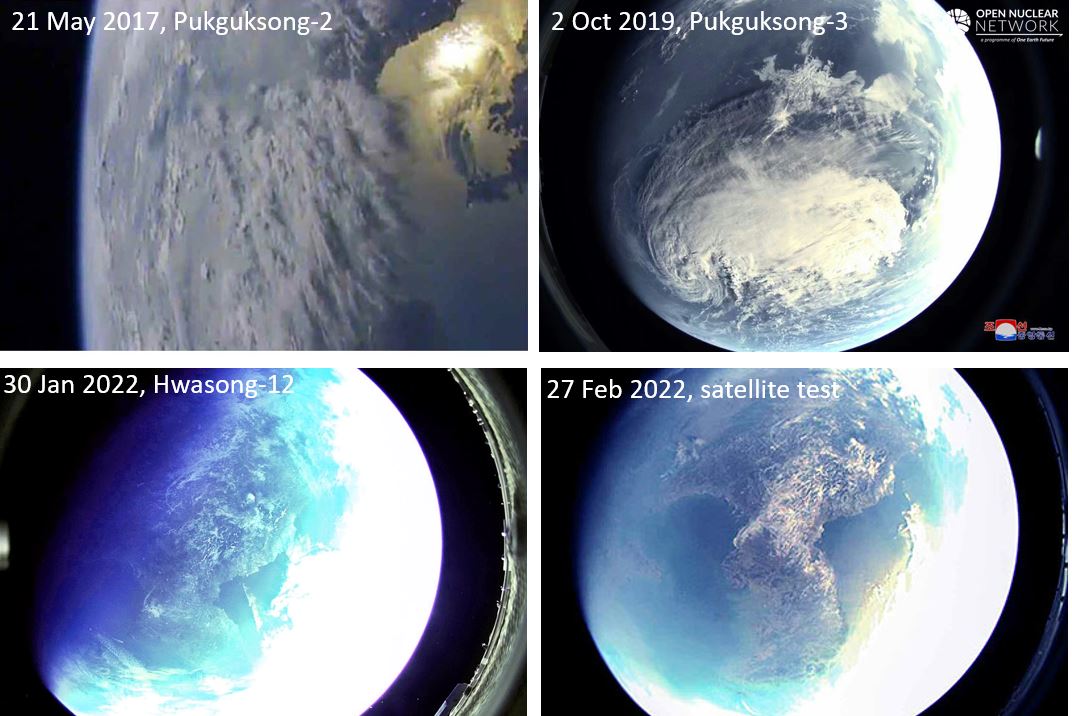
Figure 1. Photos of earth presumably taken during previous ballistic missile tests and the satellite test on 27 February. Images: KCNA
On 5 March 2022, another similar test was conducted. The projectile this time reached an apogee of roughly 550 km before splashing down 300 km away from around the Sunan area. [10] KCNA reported that NADA "confirmed the reliability of data transmission and reception system of the satellite, its control command system and various ground-based control systems" through this test. [11] Considering the short interval between the two tests, the rockets and test payloads may have been manufactured in the same production cycle.
It is rare to test satellite technologies in a highly lofted ballistic trajectory. However, considering that the previous two satellites sent into orbit by the DPRK reportedly began tumbling shortly after orbital insertion, [12] it is possible that the DPRK decided to conduct such tests first to verify key technologies before the next launch.
Kim Jong Un's Visits
Visit to NADA
Kim Jong Un reportedly visited the NADA in Pyongyang on 9 March 2022. He was quoted by KCNA as saying that:
"The development of a reconnaissance satellite takes an important share in attaining the five major goals for developing the defence power set forth at the 8th Party Congress … the purpose of developing and operating the military reconnaissance satellite is to provide the armed forces of the DPRK with real-time information on military actions against it by the aggression troops of the U.S. imperialism and its vassal forces … the Party Central Committee fully supports the decision of the National Aerospace Development Administration on putting a lot of military reconnaissance satellites into diverse sun-synchronous polar orbits in the period of the five-year plan."
It is not immediately clear what the "five major goals for developing the defence power" are, as the relevant official text on the 8th Congress of the Workers' Party of Korea was not explicit [13] (see attachment). It is also not clear if "putting a lot of military reconnaissance satellites into diverse sun-synchronous polar orbits" [14] means that DPRK plans to conduct multiple satellite launches in the future, or if DPRK is working on sending two or more satellites into orbits in a single launch.
According to images released by KCNA, presumed flight paths of the 27 February and 5 March 2022 tests were shown to Kim Jong Un during his visit to NADA (Figure 2).
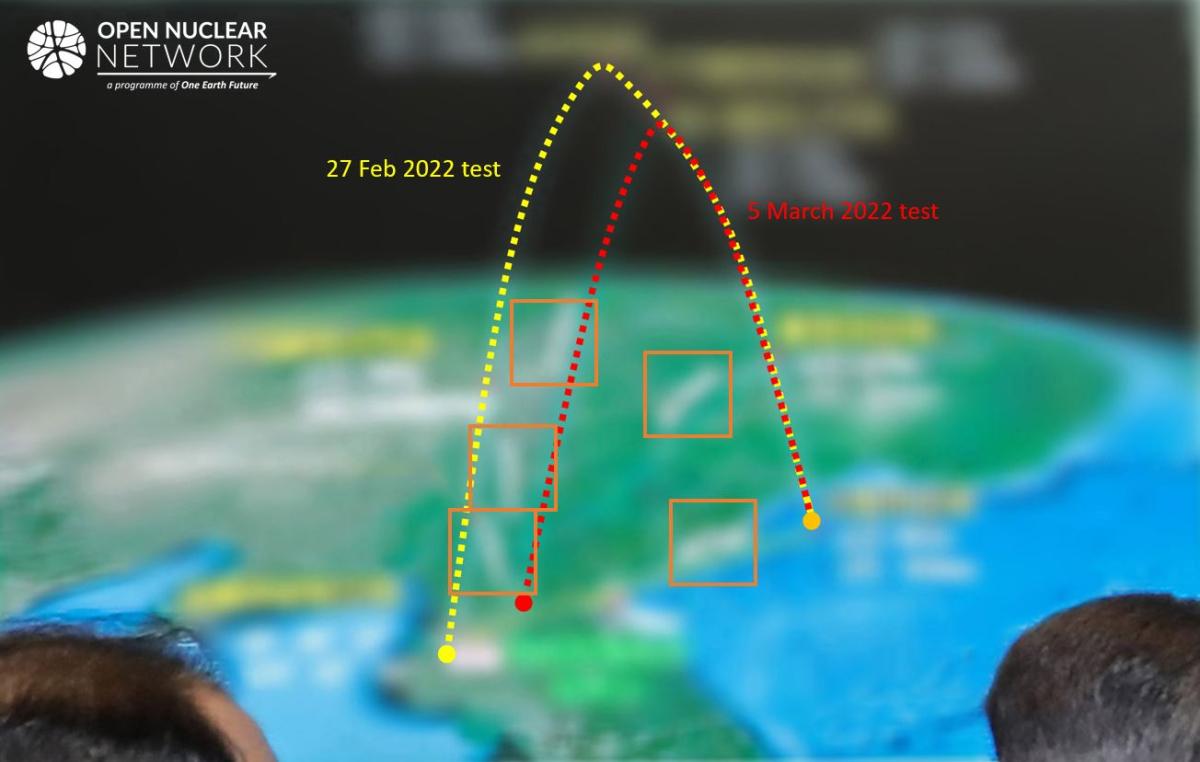
Figure 2. Presumed flight paths displayed to Kim Jong Un. Several blurred rectangular shapes (in orange boxes) might indicate the free flight path of a spent rocket stage after engine burn-out. Image: KCNA
More photos, taken by the test payloads presumably during 27 February and 5 March 2022 launches, were also shown to Kim Jong Un (Figure 3).
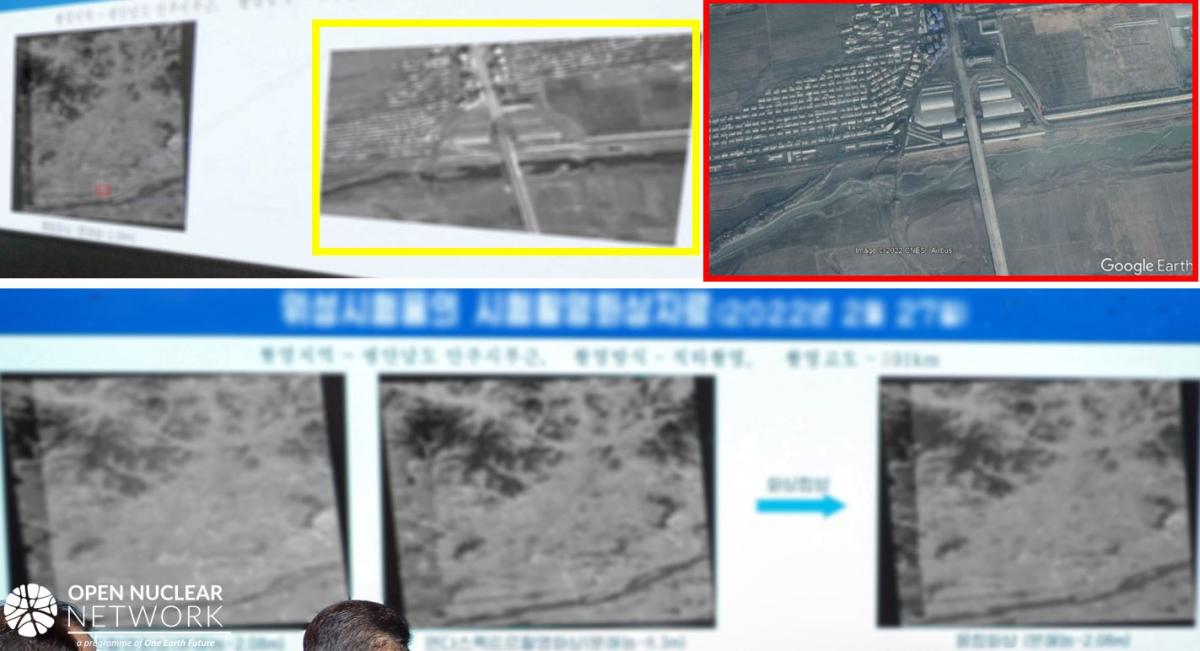
Figure 3. Grayscale images presumably taken by the test payloads. Image in the yellow box appears to match a location in Anju (in red box), about 45 km north of Sunan. [15]
Images: KCNA, Google Earth (in red box)
Visit to Sohae Satellite Launching Ground
Kim Jong Un reportedly visited the Sohae Satellite Launching Ground on 10 March 2022 and gave orders to upgrade and expand this launching ground (Figure 4). [16] This is his first public visit to Sohae since the 7 February 2016 satellite launch.
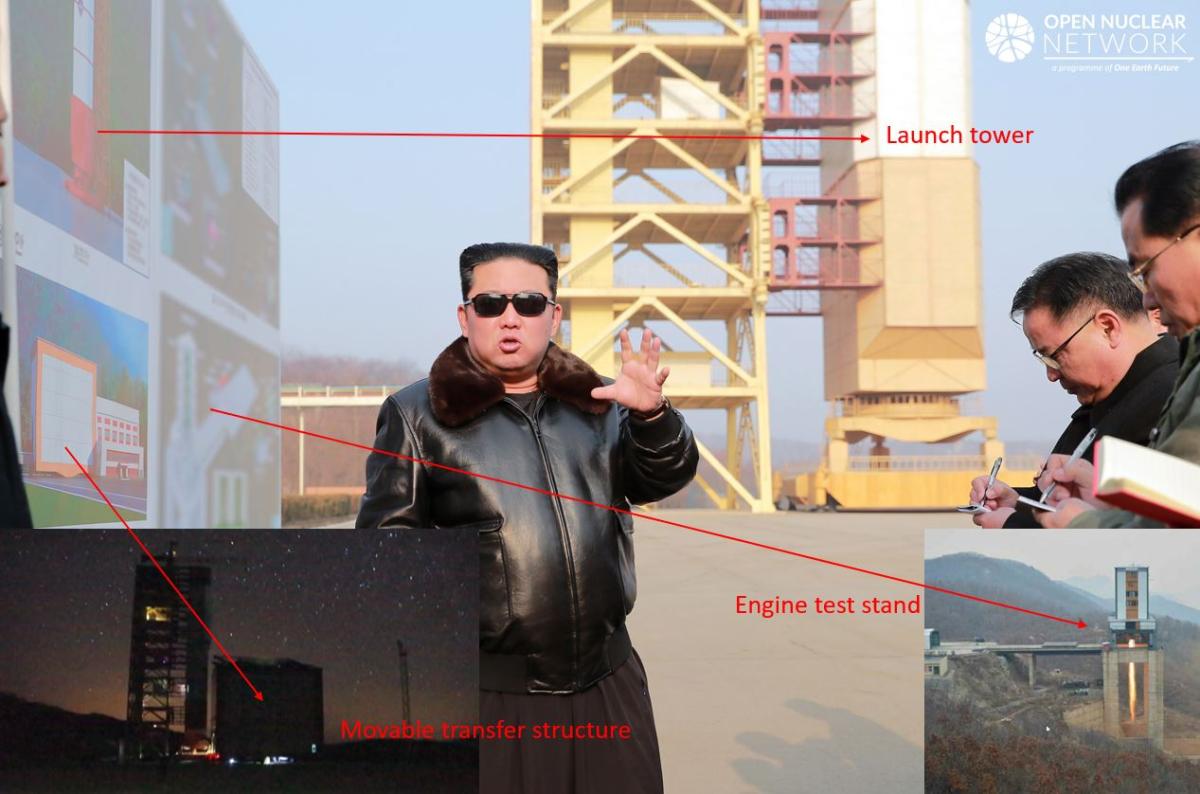
Figure 4. Kim Jong Un giving instructions at the Sohae Satellite Launching Ground. Images: KCNA, KCTV
Specifically, KCNA reported that Kim Jong Un:
"advanced the task to modernize [the Sohae Satellite Launching Ground] so that various rockets could be launched to carry multi-purpose satellites, including a military reconnaissance satellite, in the future … . He also gave detailed instructions as regards the matters arising in modernizing the Sohae Satellite Launching Ground, including the matters of expanding the capacity of the engine ground jet test site, ensuring the convenience of carrier rocket transport, improving the ecological environment around the launching ground and building a grandstand in the safe zone opposite to the launching ground." [17]
Commercial satellite image from 11 March 2022 shows an object at the launch pad area (Figure 5). The object may be the billboard shown to Kim Jong Un during his visit to Sohae; the low resolution of the image does not allow for a more confident assessment.
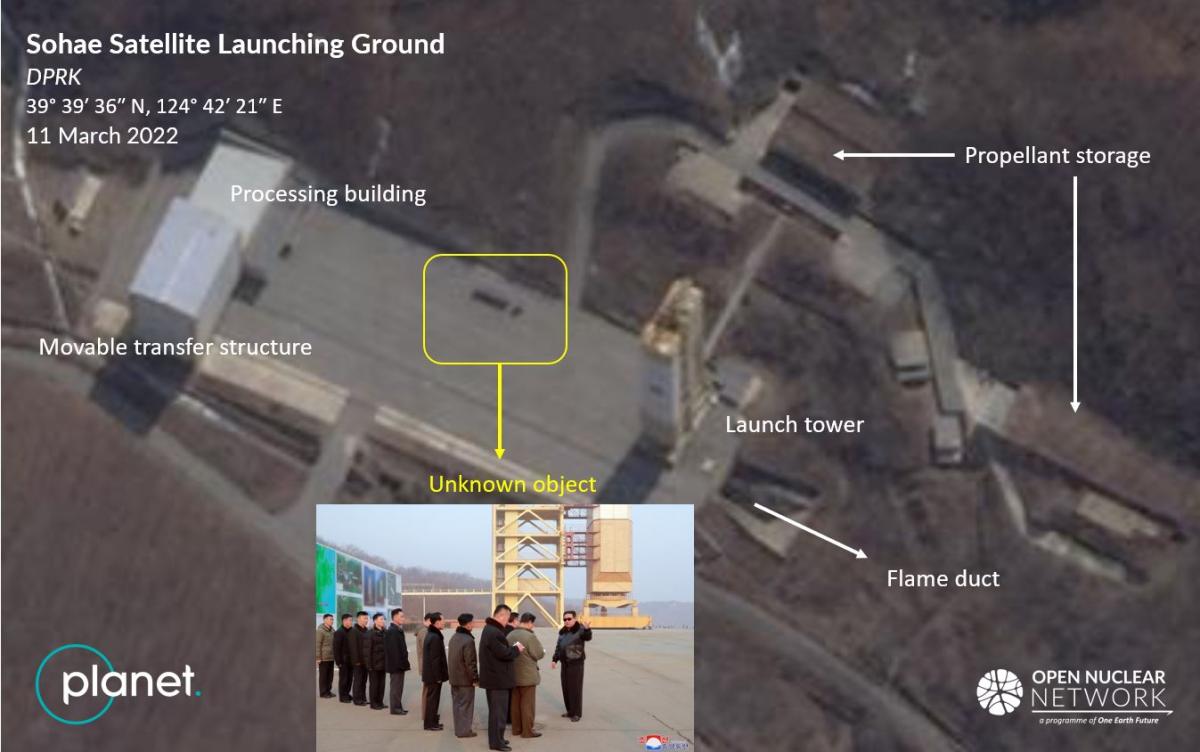
Figure 5. Satellite image taken one day after Kim Jong Un's visit (inset photo) shows an object (in yellow box) on the launch pad area at Sohae. Images: © 2022 Planet Labs Inc. All Rights Reserved, KCNA
US Announcements
US Indo-Pacific Command
On 9 March 2022, the US Indo-Pacific Command issued a press release, stating that in light of the series of ballistic missile launches of the DPRK, the Command had "ordered intensified Intelligence, Surveillance, and Reconnaissance collection activities in the Yellow Sea, as well as enhanced readiness among our ballistic missile defense forces in the region." [18]
The mentioning of the Yellow Sea is noteworthy as the DPRK normally launches ballistic missiles towards the east. It has only launched towards the south when it attempted to put satellites into sun-synchronous orbits from the Sohae Satellite Launching Ground, in which cases the first stage rockets and payload fairings fell into the Yellow Sea. As opposed to ballistic missile launches, the DPRK announced the splash zones and launch windows for its previous satellite launch attempts in 2009, 2012 and 2016. [19] The announcement seems to indicate that the Command believes another satellite launch could take place in the near future.
US Department of Defence
According to the US DoD press release issued on 10 March 2022, the US believes that the flight tests conducted by the DPRK on 27 February and 5 March 2022 involved a new ICBM that the DPRK is developing, [20] which was first revealed during a military parade on 10 October 2020 (Figure 6). [21] The new ICBM is possibly designated as "Hwasong-17." [22]
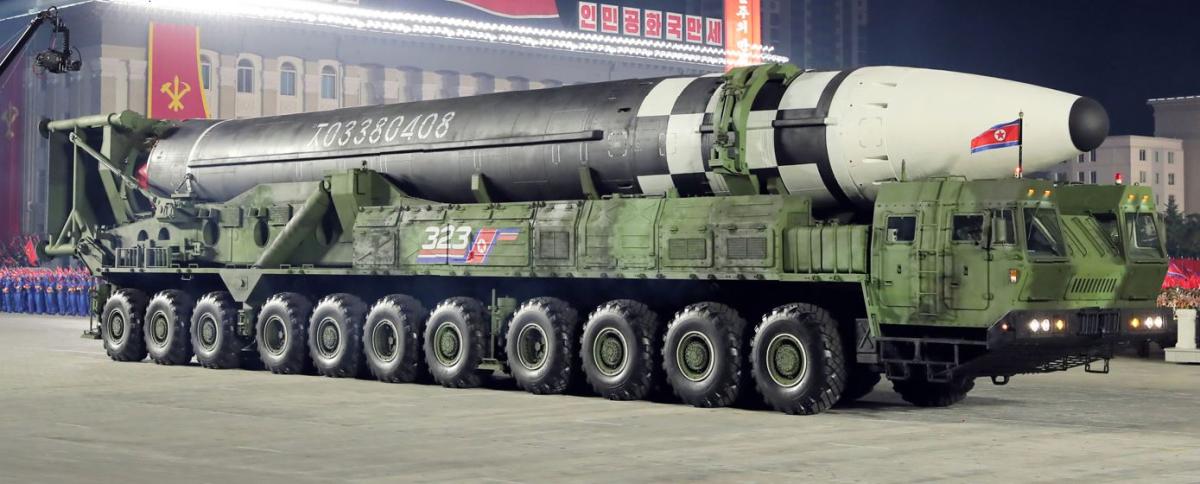
Figure 6. The new ICBM was first revealed during a military parade in Pyongyang on 10 October 2020. Image: KCNA
Though the tests did not demonstrate the ICBM range, the purpose of the tests was likely to evaluate the new missile before a full range test, according to the US DoD, which further concluded that the full-range ICBM test might be disguised as a satellite launch. Due to lack of usable satellite images and telemetry data available to ONN, it is unclear what technologies of the new ICBM were being evaluated during the 27 February and 5 March 2022 tests.
According to the press release, the US is revealing the information publicly and sharing it with its allies and partners so that the international community could "speak in a united voice." [23] This information sharing approach is reminiscent of the proactive release of intelligence by the White House prior to Russian military operations in Ukraine.
Conclusions
-
The recent activities in the DPRK have been the strongest indicators since early 2016 of a possible satellite launch. The likelihood of such a satellite launch is further supported by US intelligence reports, which has also claimed that such satellite launch would be a cover for the testing of new ICBM technologies.
-
In 2009, 2012 and 2016, the DPRK announced launch windows and splash zones for rocket stages and fairings prior to the satellite launch activities. It remains to be seen if the DPRK would follow the same procedure for its next satellite launch.
-
The possibility that the DPRK would first conduct an ICBM test and/or a nuclear test before a satellite launch cannot be ruled out at this point.
ONN will continue to monitor the WMD-related programmes of the DPRK.
Attachment
Excerpt from KCNA report on Report Made by Supreme Leader Kim Jong Un at Eighth Congress of WPK, 10 January 2021
The report mentioned the core plan and strategic tasks of crucial importance in rapidly developing and strengthening the national defence industry.
It is necessary to develop the nuclear technology to a higher level and make nuclear weapons smaller and lighter for more tactical uses. This will make it possible to develop tactical nuclear weapons to be used as various means according to the purposes of operational duty and targets of strike in modern warfare, and continuously push ahead with the production of super-sized nuclear warheads. In this way we will be able to thoroughly contain, control and handle on our own initiative various military threats on the Korean peninsula, which are inevitably accompanied the nuclear threat.
The report also set a goal of attaining an advanced capability for making a preemptive and retaliatory nuclear strike by further raising the rate of precision good enough to strike and annihilate any strategic targets within a range of 15 000 kilometres with pinpoint accuracy.
And the tasks were brought up to develop and introduce hypersonic gliding flight warheads in a short period, push ahead with the development of solid-fuel engine-propelled inter-continental underwater and ground ballistic rockets as scheduled, and possess a nuclear-powered submarine and an underwater-launch nuclear strategic weapon which will be of great importance in raising the long-range nuclear striking capability.
The report also referred to the need to secure the ability of reconnaissance and information gathering based on operation of a military reconnaissance satellite in the near future, and conduct in real earnest the most important research to develop reconnaissance drones and other means of reconnaissance capable of precisely reconnoitering up to 500 km deep into the front.
[1] NADA and Academy of Defense Science Conduct Important Test for Developing Reconnaissance Satellite, KCNA, 28 February 2022, available at: http://kcna.kp/en/article/q/134a0eb1839cb01381c703e991441821626900636b450ec5e8 6bd0c9b9807ee0.kcmsf
[2] NADA and Academy of Defense Science Conduct Another Important Test for Developing Reconnaissance Satellite, KCNA, 6 March 2022, available at: http://kcna.kp/en/article/q/134a0eb1839cb01381c703e991441821d4e24a0a2d9f3b84ee 50c4fe4859843c.kcmsf
[3] INDOPACOM increases ISR, BMD readiness in response to continued DPRK missile launches, US INDOPACOM Public Affairs, 9 March 2022, available at: https://www.pacom.mil/Media/News/News-Article-View/Article/2960710/
[4] Respected Comrade Kim Jong Un Inspects National Aerospace Development Administration, KCNA, 10 March, available at: http://kcna.kp/en/article/q/1fe2ae4345801108027d3b16464fb830.kcmsf
[5] Statement by Pentagon Press Secretary John Kirby on Recent DPRK Missile Tests, US DoD, 10 March 2022, available at: https://www.defense.gov/News/Releases/Release/Article/2963053/statement-bypentagon-press-secretary-john-kirby-on-recent-dprk-missile-tests/
[6] Respected Comrade Kim Jong Un Inspects Sohae Satellite Launching Ground, KCNA, 11 March 2022, available at: http://kcna.kp/en/article/q/a1ba2235fd47e81cb8c8a8ec79f37f26.kcmsf
[7] NADA and Academy of Defense Science Conduct Important Test for Developing Reconnaissance Satellite, KCNA, 28 February 2022, available at: http://kcna.kp/en/article/q/134a0eb1839cb01381c703e991441821626900636b450ec5e8 6bd0c9b9807ee0.kcmsf
[8] 北朝鮮のミサイル等関連情報 [Press release on DPRK missile launch], Japan MoD, 11 March 2022, available at: https://www.mod.go.jp/j/press/news/2022/03/11d.html; Song Sang-ho and Kang Yoon-seung, N. Korea fires 1 ballistic missile toward East Sea: S. Korean military, Yonhap News Agency, 27 February 2022, available at: https://en.yna.co.kr/view/AEN20220227000354325
[9] According to KCNA, the test "confirms the characteristics and working accuracy of high definition photographing system, data transmission system and attitude control devices by conducting vertical and oblique photographing of a specific area on earth with cameras to be loaded on the reconnaissance satellite." See: NADA and Academy of Defense Science Conduct Important Test for Developing Reconnaissance Satellite, KCNA, 28 February 2022, available at: http://kcna.kp/en/article/q/134a0eb1839cb01381c703e991441821626900636b450ec5e8 6bd0c9b9807ee0.kcmsf
[10] 北朝鮮のミサイル等関連情報 [Press release on DPRK missile launch], Japan MoD, 11 March 2022, available at: https://www.mod.go.jp/j/press/news/2022/03/11d.html; Song Sang-ho and Kang Yoon-seung, N. Korea fires 1 ballistic missile toward East Sea: S. Korean military, Yonhap News Agency, 5 March 2022, available at: https://en.yna.co.kr/view/AEN20220305000853325
[11] NADA and Academy of Defense Science Conduct Important Test for Developing Reconnaissance Satellite, KCNA, 28 February 2022
[12] The Kwangmyongsong-3-2 satellite was launched in December 2012 and reportedly lost stabilization after orbit insertion. See: Eric Talmadge, Crippled NKorean Probe could Orbit for Years, AP, 18 December 2012, available at: https://web.archive.org/web/20131029210856/http://bigstory.ap.org/article/cripplednkorean-probe-could-orbit-years?goback=.gde_3433693_member_197139555; The Kwangmyongsong-4 satellite was launched in February 2016 and reportedly met the same technical troubles but appeared to have regained control. See: Andrea Shalal, David Brunnstrom, North Korea satellite in stable orbit but not seen transmitting: U.S. sources, Reuters, 9 February 2016, available at: https://www.cbsnews.com/news/north-korea-satellitetumbling-in-orbit-u-s-officials-say/. In an interview with Associated Press, a DPRK official claimed that the Kwangmyongsong-4 "transmitted 700 photographic images back to Earth within one day after its launch" and that the satellite was "still working properly and sending data" whenever it passed over the DPRK. See: Eric Talmadge, AP Exclusive: North Korea hopes to plant flag on the moon, AP, 4 August 2016, available at: https://apnews.com/article/88fa76909dec40b299658a34b489dc1a#:~:text=In%20an%20in terview%20with%20The,within%20the%20next%2010%20years. In May 2017, the DPRK state television published what it claimed to be satellite images of the THAAD missile defense systems deployed in the ROK, without specifying the source of the images. See: N. Korea unveils "satellite photos" of THAAD in S. Korea, Yonhap News Agency, 10 May 2017, available at: https://m-en.yna.co.kr/view/AEN20170510009000315. However, the DPRK's claim regarding the working condition of the Kwangmyongsong-4 could not be verified.
[13] In a previous brief, ONN did not include satellite launch as one of the five major goals. See: Xu Tianran, January 2022: Missile Tests of the DPRK, ONN, 1 February 2022, available at: https://opennuclear.org/publication/january-2022-missile-tests-dprk
[14] Sun-synchronous orbit is a kind of polar orbit. Satellites in polar orbits usually travel past earth from north to south, passing roughly over earth's poles. Satellites in such orbits always visit the same spot at the same time. See: Polar and Sun-synchronous orbit, European Space Agency, 2 March 2020, available at: https://www.esa.int/ESA_Multimedia/Images/2020/03/Polar_and_Sun-synchronous_orbit
[15] First discovered by Dave Schmerler, Senior Research Associate, James Martin Center for Nonproliferation Studies: https://twitter.com/DaveSchmerler/status/1501686724983934985?s=20&t=KtHCg5g5CPr EKeh5H_iJtg
[16] Respected Comrade Kim Jong Un Inspects Sohae Satellite Launching Ground, KCNA, 11 March 2022, available at: http://kcna.kp/en/article/q/a1ba2235fd47e81cb8c8a8ec79f37f26.kcmsf
[17] Respected Comrade Kim Jong Un Inspects Sohae Satellite Launching Ground, KCNA, 11 March 2022, available at: http://kcna.kp/en/article/q/a1ba2235fd47e81cb8c8a8ec79f37f26.kcmsf
[18] INDOPACOM increases ISR, BMD readiness in response to continued DPRK missile launches, US INDOPACOM Public Affairs, 9 March 2022, available at: https://www.pacom.mil/Media/News/News-Article-View/Article/2960710/
[19] North releases details of rocket's flight path, Hankyoren, 14 March 2009, available at: https://english.hani.co.kr/arti/english_edition/e_northkorea/344109.html; Martin Williams, Launch plans indicate largely unchanged Unha 3 rocket, North Korea Tech, 3 February 2016, available at: https://www.northkoreatech.org/2016/02/03/launch-plans-indicate-largelyunchanged-unha-3/
[20] Statement by Pentagon Press Secretary John Kirby on Recent DPRK Missile Tests, US DoD, 10 March 2022, available at: https://www.defense.gov/News/Releases/Release/Article/2963053/statement-bypentagon-press-secretary-john-kirby-on-recent-dprk-missile-tests/
[21] Xu Tianran, Two key questions about North Korea's new missile, Bulletin of the Atomic Scientists, 22 October 2020, available at: https://thebulletin.org/2020/10/two-keyquestions-about-north-koreas-new-missile/
[22] Xu Tianran, Brief on the Defence Development Exhibition of the Democratic People's Republic of Korea, ONN, 20 October 2021, available at: https://opennuclear.org/publication/brief-defence-development-exhibition-democratic-peoples-republic-korea-0
[23] Statement by Pentagon Press Secretary John Kirby on Recent DPRK Missile Tests, US DoD, 10 March 2022, available at: https://www.defense.gov/News/Releases/Release/Article/2963053/statement-bypentagon-press-secretary-john-kirby-on-recent-dprk-missile-tests/